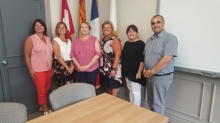
Press Release
Wednesday, November 09, 2016
The DILan Project: A Winning Public-Private-University Partnership Model in Language Technology Research and Development

On the photo, from left to right: Judy Ross, Acting Vice President, Enterprise Services, Service New Brunswick; Nathalie Levesque, Chief Executive Officer, Transmed; Anne Rae, Manager, Application Services, Service New Brunswick; Rachel Arseneau-Ferguson, President, Transmed; Pascale Bergeron, Director, Translation Bureau, Service New Brunswick; and Sid Ahmed Selouani, LARIHS Director, Université de Moncton, Shippagan campus, at the July 28, 2016 meeting convened to assess the DILan project.
View Full-Size Image
With that in mind, and in response to ever growing needs in the translation field, an innovative partnership model was implemented based on close technical cooperation between the New Brunswick Translation Bureau, Campbellton-based translation firm Transmed, and LARIHS, UMCS2 laboratory for research on human/system interaction. This maximizing of resources and leveraging of LARIHS’ existing expertise have led to more cutting-edge research and the development of innovative language technology products for the marketplace.
Working closely with industry, the partnership’s aim is to develop technology that allows translation firms to optimize their handling processes and thereby enhance their productivity. Under the partnership, bilateral agreements were signed between the Translation Bureau and Transmed, guaranteeing the latter a sufficient volume of documents for translation, and between Transmed and UMCS, whereby Transmed provides the researchers with the necessary human and linguistic resources. The agreements have allowed Transmed to recruit staff to work directly with researchers on site in Shippagan. The advantage of this type of partnership model is that it gives researchers a privileged window into the translation world and allows them to apply and validate their methods in a real-life setting.
The R&D prototypes are designed, tested and validated using feedback from, and evaluations of, professional translators. The DILan software suite, designed specifically for the project and consisting of several modules (DILan partage, DILan ressource, DILan ergo and Dilan vocTrad), was presented at the July 28 meeting. DILan partage optimizes the electronic sharing of documents between clients and translation staff to enhance reliability and efficiency. DILan ressource gives personalized and smart access to available resources, resulting in significant time savings and greater ease for translation staff. DILan ergo measures parameters that determine a translator’s cognitive load depending on the various tasks performed. DILan vocTrad utilizes voice-based technologies developed at LARIHS to improve translator/machine interaction by minimizing keyboard use while filtering out noise in the workplace and adapting to different spoken accents. Improvements to the modules are underway, with the ultimate goal of marketing the final products.
It is important to highlight the invaluable contribution of the project’s financial partners: the Regional Development Corporation of New Brunswick; the New Brunswick Innovation Foundation’s Research Innovation Fund (Concept Validation); the Atlantic Canada Opportunities Agency’s Business Development Program; the National Engineering and Research Council of Canada’s Discovery Grant Program; the Canadian Foundation for Innovation’s Leaders Fund; and, finally, UMCS. Total funding for the project comes to $1.149 million. Twenty people have been recruited: two post-doctoral researchers, four doctoral students, six research assistants, two Master’s students, one project coordinator and one research technician. Two additional people will be joining the team in the next two years. Moreover, Transmed has created three additional positions thanks to the project, two of which are on site at the Shippagan campus.
Since 2002, UMCS has developed a unique expertise and made significant peer-reviewed contributions to the language technology field that have been presented at conferences and forums. The contributions are varied and target several everyday applications, including robust voice-based e-services, language learning aids, automatic translation, web-voice applications, assistance for the language-impaired, and interactive mobile telecommunications, employing a variety of language variants such as standard French, Acadian French, and English. LARIHS has conducted many highly specialized research projects in the field of multilingual language technology, enabling it to build a network of collaboration and strategic partnerships with experts from universities and research centres provincially, nationally and internationally.
__________________________________________________
1DILan is a French acronym that stands for language industry development’
2Université de Moncton, Shippagan Campus
Return to Press release


